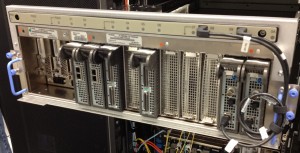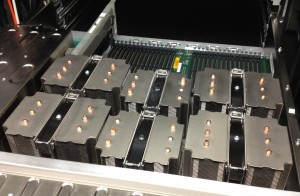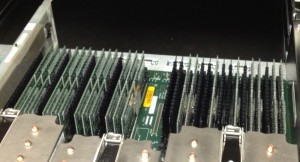Apparently the problem that I blogged about last week where Knight Capital lost $440 million in 45 minutes was not caused by a software bug. Instead, it looks like the program written to generate fake transactions while testing in the lab was accidentally included in the package when the trading program was moved to a live test. I wouldn’t want to be the person who put together that package.
Monthly Archives: August 2012
Innards
While IBM’s John Ward was upgrading the memory on our z10 BC Sunday morning, I took some pictures.
Starting from the left, there are power supplies, then two service processors (little computers that manage the configuration and microcode and such), then six slots for I/O fanouts (only two are populated, since we only have two I/O cages and no coupling links), and then two timing circuits.
Here is the top of the drawer after John removed all the old memory cards. In the front you see the top of the heat sinks for the processor and controller chips. The four chips on the left and right are the processor chips while the two in the middle are system controller chips (they manage the clocks and memory accesses and contain L2 cache.) To the left are the tops of the power supplies. At the back are the empty slots for the memory cards.
Here’s the back of the drawer after John has finished installing the new memory.
$10 million a minute
Like anyone else who’s ever written a program, I’ve written programs with bugs in them. But I’ve never aspired to writing a program that can lose $10 million a minute. “Buy high and sell low” doesn’t sound like a path to fortune, although apparently it can get you some fame.


